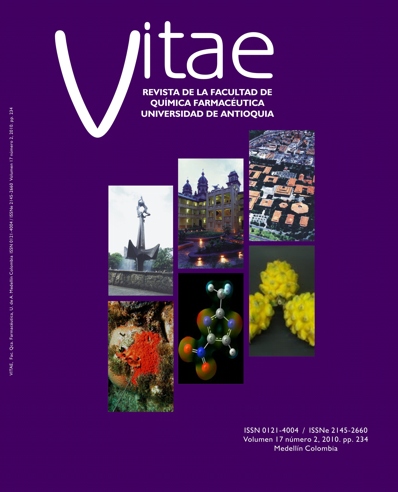PEPTIDES WITH ANTIMICROBIAL ACTIVITY PRODUCED BY ISOLATED NATIVE MICROORGANISMS
DOI:
https://doi.org/10.17533/udea.vitae.6343Keywords:
antimicrobial cationic peptides, soil microbiology, thin layer chromatographyAbstract
Like proteins, antimicrobial peptides (AMP) are versatile molecules synthesized by microorganisms using enzymatic pathways with no genetic code instruction. AMP have interesting properties in the food and pharmaceutical industries, like their antimicrobial ability against pathogens. Looking for biomolecules from microorganisms requires hard and time consuming chemical analysis of each microorganism extract. The microorganism isolation method proposed in this research allowed us to find antimicrobial peptides produced by bacteria, through interaction between a charged dye mixed with selective agar and metabolites produced by microorganisms. Twenty soil samples from different zones were isolated in selective media; thirty five strains were purified based on interaction between basic dye and charged molecules from bacteria. Streptomyces sp. y Bacillus sp. both genera were identified. Protein extracts were obtained from the isolated microorganisms cultivated in liquid media; peptides and amino acids were identified by thin layer chromatography and electrophoresis. Those extracts with high protein level were used to evaluate bioautography. Two extracts from 35 showed inhibitory activity against E. coli ATCC 8739 (8 mm halo). Method effectiveness for the isolation and the purifying of microorganisms able to produce charged molecules, of industrial interest is demonstrated.Downloads
Downloads
Published
How to Cite
Issue
Section
License
Copyright Notice and Open Access Statement
The Journal Vitae works under the Open Access license, and the published manuscripts remain available for the public, both on the Journal's website and in databases, under the Creative Commons license, "Noncommercial Attribution" and "Share alike" systems, adopted in Colombia. Hence, when the authors agree to publish in the Journal Vitae, they will not have the right to economic retributions on publications and reproductions through different diffusion media. The documents are freely available to the internet public, permitting users to read, download, copy, distribute, print, search, or link to the full texts and pass them as data to software. The only constraint on reproduction and distribution, should be to give authors control over the integrity of their work and the right to be appropriately acknowledged and cited.
Authors declare that:
-
They are the intellectual property owners and are responsible for all the information stated in the article.
-
This manuscript has not been submitted or published in other printed or digital media. They accept the responsibility for the judgments, opinions, and points of view expressed in the published article and, therefore, they exonerate Universidad de Antioquia and Journal Vitae from any process.
-
They exempt Universidad de Antioquia and Journal Vitae from settling conflicts or disputes related to the authorship of the referred article.
-
They accept the revision of the original manuscript by suitable personnel, and they bind themselves to perform the corrections appointed or suggested by the assessors.
-
Therefore, they know the editorial process and will not bind the Editorial Board of the Journal to assume any obligations regarding the volume and issue in which the article is published.
-
They transfer the rights of publication, reprinting, and distribution of the article from the moment of its approval, in print and digital format, without the right to economic rewards, and under the licensing conditions considered relevant by Journal Vitae.
-
They fully authorize Universidad de Antioquia and Journal Vitae to submit the published material to the diverse databases and indexing systems where the Journal can be found to comply with the requirements of the regulatory authorities to maintain the national classification of journals.
-
They will assume the article publication costs established for the current issue, and they will make the payment as soon as they are informed about the volume and the issue in which the final version of the article is published.
-
After the article is published, you can share digital or printed copies in a noncommercial manner. You will be able to use the paper in your institution or company for educational or research purposes, including the use in course programs.
Conflict of interest: Authors are responsible for recognizing and disclosing any financial or other benefits that could be perceived to bias their work, acknowledging all financial support and any personal connections with potential sponsors. Examples of such conflicts include receiving research funds or honoraria, serving on advisory boards, stock ownership, or employment and consulting arrangements. Authors without such connections should clearly state that they have no financial support or personal relationships that could be perceived to bias their work. All conflicts of interest should be disclosed on the author's identification page of the manuscript.










